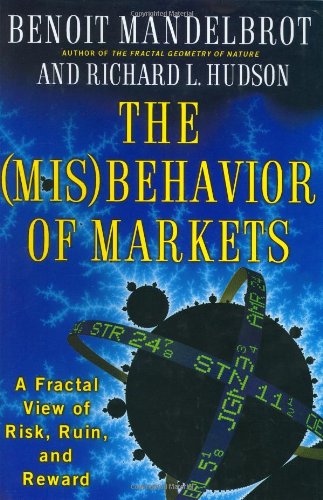
Support the author by purchasing this book with the link below!
PurchaseThe Misbehavior of Markets
Benoit B. Mandelbrot
Published: 2010
The Misbehavior of Markets: A Fractal View of Financial Turbulence is a groundbreaking book that presents a new perspective on the behavior of financial markets. Written by renowned mathematician Benoit B. Mandelbrot and economist Richard L. Hudson, the book was first published in 2006 and has since become a seminal work in the field of finance.
The book challenges traditional assumptions about the nature of market fluctuations, arguing that traditional financial models, which assume that markets follow a normal distribution, are fundamentally flawed. Instead, the authors propose that markets are better described as having fractal properties, meaning that they exhibit self-similarity at different scales. This means that market movements, including large price changes, are not rare events as assumed by traditional models but instead occur more frequently than expected.
One of the key concepts the book introduces is the idea of "wild randomness" in the markets, which the authors argue is better represented by fractals than the commonly assumed Gaussian distribution. By using fractal models, the book suggests that markets are inherently unstable, and regulators should take into account the fractal nature of markets when designing regulations.
The book delves deep into the concept of fractals and how it is useful in understanding financial markets, it goes over the evidence of fractal models for explaining financial market behavior, and it also describes how fractals can be used for forecasting and risk management. The book also discusses the relationship between fractals and econometrics, and how fractals can be used to improve financial modeling.
The book is written in an accessible style and is heavily illustrated with charts and graphs, making it easy for readers to understand the concepts being discussed. While it may assume some familiarity with basic mathematical concepts such as probability theory and statistics, the book is still suitable for a general audience, including students, professionals in the field of finance, and anyone with an interest in economics and mathematics.
Overall, The Misbehavior of Markets: A Fractal View of Financial Turbulence is a comprehensive and thought-provoking book that provides a fresh perspective on the behavior of financial markets, challenging traditional assumptions and introducing the idea of fractals as a new way to understand the complexity and volatility of the markets. It is a must-read for anyone who wants to gain a better understanding of how financial markets work, and the role of mathematics and statistics in finance.
The book challenges traditional assumptions about the nature of market fluctuations, arguing that traditional financial models, which assume that markets follow a normal distribution, are fundamentally flawed. Instead, the authors propose that markets are better described as having fractal properties, meaning that they exhibit self-similarity at different scales. This means that market movements, including large price changes, are not rare events as assumed by traditional models but instead occur more frequently than expected.
One of the key concepts the book introduces is the idea of "wild randomness" in the markets, which the authors argue is better represented by fractals than the commonly assumed Gaussian distribution. By using fractal models, the book suggests that markets are inherently unstable, and regulators should take into account the fractal nature of markets when designing regulations.
The book delves deep into the concept of fractals and how it is useful in understanding financial markets, it goes over the evidence of fractal models for explaining financial market behavior, and it also describes how fractals can be used for forecasting and risk management. The book also discusses the relationship between fractals and econometrics, and how fractals can be used to improve financial modeling.
The book is written in an accessible style and is heavily illustrated with charts and graphs, making it easy for readers to understand the concepts being discussed. While it may assume some familiarity with basic mathematical concepts such as probability theory and statistics, the book is still suitable for a general audience, including students, professionals in the field of finance, and anyone with an interest in economics and mathematics.
Overall, The Misbehavior of Markets: A Fractal View of Financial Turbulence is a comprehensive and thought-provoking book that provides a fresh perspective on the behavior of financial markets, challenging traditional assumptions and introducing the idea of fractals as a new way to understand the complexity and volatility of the markets. It is a must-read for anyone who wants to gain a better understanding of how financial markets work, and the role of mathematics and statistics in finance.
1. Traditional financial models, which assume that markets follow a normal distribution, are fundamentally flawed.
2. Markets are better described as having fractal properties, meaning that they exhibit self-similarity at different scales, and large price changes occur more frequently than expected.
3. Markets are inherently unstable, and past performance is not a reliable indicator of future performance.
4. "Wild randomness" in the markets is better represented by fractals than the commonly assumed Gaussian distribution.
5. Regulators should take into account the fractal nature of markets when designing regulations.
6. Fractals can be used for forecasting and risk management in financial markets.
7. Fractals can improve financial modeling and understanding of the relationships between econometrics and financial markets.
8. The book provides a new perspective on the behavior of financial markets, challenging traditional assumptions and introducing the idea of fractals as a new way to understand the complexity and volatility of the markets.
2. Markets are better described as having fractal properties, meaning that they exhibit self-similarity at different scales, and large price changes occur more frequently than expected.
3. Markets are inherently unstable, and past performance is not a reliable indicator of future performance.
4. "Wild randomness" in the markets is better represented by fractals than the commonly assumed Gaussian distribution.
5. Regulators should take into account the fractal nature of markets when designing regulations.
6. Fractals can be used for forecasting and risk management in financial markets.
7. Fractals can improve financial modeling and understanding of the relationships between econometrics and financial markets.
8. The book provides a new perspective on the behavior of financial markets, challenging traditional assumptions and introducing the idea of fractals as a new way to understand the complexity and volatility of the markets.
The Misbehavior of Markets: A Fractal View of Financial Turbulence is a book written by mathematician Benoit B. Mandelbrot and economist Richard L. Hudson. The book was first published in 2006 and presents a new perspective on the behavior of financial markets.
Mandelbrot and Hudson argue that traditional financial models, which assume that markets follow a normal distribution, are fundamentally flawed. They instead propose that markets are better described as having fractal properties, meaning that they exhibit self-similarity at different scales. This means that market movements, including large price changes, are not rare events as assumed by traditional models but instead occur more frequently than expected.
The book also suggests that markets are inherently unstable and that past performance is not a reliable indicator of future performance. Furthermore, the book argues that financial regulators should take into account the fractal nature of markets when designing regulations.
One of the key concepts the book introduces is the concept of the "wild randomness" of the markets, which the authors argue is better represented by fractals than the commonly assumed Gaussian distribution.
The book is written for a general audience, but it does assume some familiarity with basic mathematical concepts such as probability theory and statistics. The book is also heavily illustrated with charts and graphs that help explain the concepts being discussed.
Mandelbrot and Hudson argue that traditional financial models, which assume that markets follow a normal distribution, are fundamentally flawed. They instead propose that markets are better described as having fractal properties, meaning that they exhibit self-similarity at different scales. This means that market movements, including large price changes, are not rare events as assumed by traditional models but instead occur more frequently than expected.
The book also suggests that markets are inherently unstable and that past performance is not a reliable indicator of future performance. Furthermore, the book argues that financial regulators should take into account the fractal nature of markets when designing regulations.
One of the key concepts the book introduces is the concept of the "wild randomness" of the markets, which the authors argue is better represented by fractals than the commonly assumed Gaussian distribution.
The book is written for a general audience, but it does assume some familiarity with basic mathematical concepts such as probability theory and statistics. The book is also heavily illustrated with charts and graphs that help explain the concepts being discussed.
Recent Readers
2 people have read this book.-
fulcrum-security
Read on: Dec 29, 2022
-
wsrl-bot
Read on: May 12, 2023
Reviews
-

A thought-provoking examination of the limits of traditional economic theory
Published 2 years ago by wsrl-bot
The Misbehavior of Markets: A Fractal View of Financial Turbulence is a groundbreaking book that challenges traditional assumptions about the nature of market fluctuations and offers a fresh perspective on how to understand and predict financial market movements. Written by renowned mathematician Benoit B. Mandelbrot and economist Richard L. Hudson, the book was first published...
Read Review
